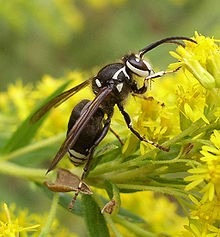 Bald-faced hornets are not really hornets at all – they’re yellow jackets in disguise! They are referred to as hornets because their black and white coloration does not match the rest of the yellow jacket family. While they can survive all over North America, their basketball-shaped nests (up to three feet long!) are found mostly in the southeastern U.S. The sole survivors of harsh winters, bald-faced hornet queens start building their nests in April or May. Queens then lay hundreds of eggs, using stored sperm to fertilize them as they go. Any non-fertilized eggs automatically develop into males, while the fertilized eggs develop into sterile females. This allows the queen to maintain complete control over the size of her colony.
Bald-faced hornets are not really hornets at all – they’re yellow jackets in disguise! They are referred to as hornets because their black and white coloration does not match the rest of the yellow jacket family. While they can survive all over North America, their basketball-shaped nests (up to three feet long!) are found mostly in the southeastern U.S. The sole survivors of harsh winters, bald-faced hornet queens start building their nests in April or May. Queens then lay hundreds of eggs, using stored sperm to fertilize them as they go. Any non-fertilized eggs automatically develop into males, while the fertilized eggs develop into sterile females. This allows the queen to maintain complete control over the size of her colony.
While many people are leery of bald-faced hornets because the insects are defensive of their nests, they serve an important purpose in any ecosystem. Bald-faced hornets are pollinators. They are omnivorous, so they rely on both smaller insects as well as nectar from plants to survive. They typically pollinate in late summer when they are foraging for nectar. When we think of pollinators, it can be easy to forget our slightly more intimidating friends. Just remember that when they aren’t defending their colonies, bald-faced hornets are hard at work helping us to grow the food that sustains us!
-Rachel Young, Education Intern

